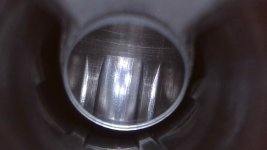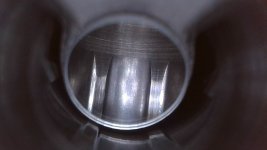Leuchtkafer
Member
I have a lot of content to put up, I'll have to break it up into multiple posts. I'd appreciate a hold on any commentary until I've completed my uploads, which will be target results. Thanks in advance.
CZ, a nice rifle for the money, but is known to be luck of the draw on how well any particular example performs. Why might that be? They give their barrels some sort of lapping process and cold hammer forge, they should be pretty decent barrels then, no? It appears that they drop the ball on the finish machining, numerous complaints can be found about crowns looking like they've been "cut with a dull butter knife" to burrs hanging off the rifling in the chamber. It got me thinking... How good would a CZ barrel be if it was finish machined properly? To answer this question I've had my nose to the grindstone, working away behind the scenes. Much of what I've been doing is content for another forum entirely, though it was necessary to get to this point and took me many months to work through.
On to the project. The barrel selected is a 24" threaded barrel from a 457 American. I found that the CZ bore is very tight, so much so that none of the reamer pilot bushings would fit it, the smallest in my set being 0.215". First task was to custom fit a bushing to the bore which ended up being 0.2122". Well actually the first thing I did was cut off the entire factory barrel tenon, as can be seen.


With that done, I setup a lapping/slugging jig. A length of delrin precision drilled and reamed for my cleaning rod to guide it without any slop. I slugged the barrel to evaluate what I was working with, and it felt really nice right up until the last few inches. I describe it sort of like a "hiccup" in the bore, felt like it was going to tighten up but then it loosened off before tightening back up to exit the muzzle.

That just won't do for this project, so I went ahead and lapped the barrel to see if that "hiccup" could be eliminated. I cast a lap and worked it until it felt worn, cleaned the barrel and slugged again to evaluate. Some improvement but still able to detect the "hiccup". I cast a second slug and lapped. After this, the slugging feels very good and I cannot detect the "hiccup" anymore.

Next I cut the new tenon for the barrel. There's a fair bit of slop in the fit between the factory barrels and actions, I did mine with minimal slop while still being easy to install and remove from the receiver.

Once the test fit was good I could proceed.

CZ, a nice rifle for the money, but is known to be luck of the draw on how well any particular example performs. Why might that be? They give their barrels some sort of lapping process and cold hammer forge, they should be pretty decent barrels then, no? It appears that they drop the ball on the finish machining, numerous complaints can be found about crowns looking like they've been "cut with a dull butter knife" to burrs hanging off the rifling in the chamber. It got me thinking... How good would a CZ barrel be if it was finish machined properly? To answer this question I've had my nose to the grindstone, working away behind the scenes. Much of what I've been doing is content for another forum entirely, though it was necessary to get to this point and took me many months to work through.
On to the project. The barrel selected is a 24" threaded barrel from a 457 American. I found that the CZ bore is very tight, so much so that none of the reamer pilot bushings would fit it, the smallest in my set being 0.215". First task was to custom fit a bushing to the bore which ended up being 0.2122". Well actually the first thing I did was cut off the entire factory barrel tenon, as can be seen.


With that done, I setup a lapping/slugging jig. A length of delrin precision drilled and reamed for my cleaning rod to guide it without any slop. I slugged the barrel to evaluate what I was working with, and it felt really nice right up until the last few inches. I describe it sort of like a "hiccup" in the bore, felt like it was going to tighten up but then it loosened off before tightening back up to exit the muzzle.

That just won't do for this project, so I went ahead and lapped the barrel to see if that "hiccup" could be eliminated. I cast a lap and worked it until it felt worn, cleaned the barrel and slugged again to evaluate. Some improvement but still able to detect the "hiccup". I cast a second slug and lapped. After this, the slugging feels very good and I cannot detect the "hiccup" anymore.

Next I cut the new tenon for the barrel. There's a fair bit of slop in the fit between the factory barrels and actions, I did mine with minimal slop while still being easy to install and remove from the receiver.

Once the test fit was good I could proceed.







































































































